|
USDA Now Accepting Nominations for New Equity Commission –
Due October 27
The Equity Commission will advise the Secretary of Agriculture by identifying USDA programs, policies, systems, structures, and practices that contribute to barriers to inclusion or access, systemic discrimination, or exacerbate or perpetuate racial, economic, health and social disparities. The Equity Commission will be composed of 15 members appointed by the Secretary of Agriculture for a two-year term and may be reappointed for up to two additional terms.
Now Open: Pandemic Response and Safety Grant Program – Applications due November 22
The Pandemic Response and Safety (PRS) Grant Program provides funding to help small specialty crop producers, food processors, manufacturers, distributors and farmers markets recover costs incurred responding to the COVID-19 pandemic, including for measures to protect workers. This program is authorized and funded under the Consolidated Appropriations Act of 2021 (Pub. L. No. 116—260). The minimum funding request amount is $1,500. The maximum funding request amount is $20,000. No cost sharing or matching funds are required. Grants will cover activities associated with:
- Workplace Safety: Implementing workplace safety measures to protect against COVID-19
- Market Pivots: Implementing market pivots to protect against COVID–19
- Retrofitting Facilities: Retrofitting facilities for worker and consumer safety to protect against COVID–19
- Transportation: Providing additional transportation options to maintain social distancing and worker and consumer safety to protect against COVID-19
- Worker Housing: Providing worker housing that protects against COVID-19
- Medical: Providing health services to protect workers against COVID-19
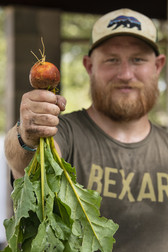
AMS’ Marketing Services Division (MSD) works to improve market access for producers and develop new markets through its three main roles as a researcher, a convener, and a technical assistance provider. In USDA’s vision, local food producers, markets, and communities have easy access to ideas, innovations, and research to grow and sustain a productive business. This information ensures that opportunities for U.S. food producers are readily available and communities are equipped to successfully grow and sell regionally produced foods, while also supporting increased access to locally produced foods. MSD accomplishes much of its work through cooperative and interagency agreements. This new document shares a summary of agreements that are currently underway.
|
In celebration of National Farm to School Month, we’re sharing some recent data and publications related to school meals.
2019 Farm to School Census
Farm to school is no longer a niche program; it’s now the standard. Over 42.8M students are in school districts that participate in farm in school. How do we know? The results of the 2019 Farm to School Census (2019 Census) are here: https://farmtoschoolcensus.fns.usda.gov/
The 2019 Census is a survey that was sent to all public, private, and charter school food authorities (SFAs, which are like school districts) that participated in the National School Lunch Program in school year 2018-19. These data include characteristics such as SFA size, eligibility rates for free and reduced-price lunch, and urbanicity, as well as information on local foods use, procurement, school gardens, expenditures, and staffing.
A whopping 12,634 SFAs responded to the 2019 Census, representing all 50 States as well as American Samoa, Guam, the Northern Mariana Islands, Puerto Rico, the U.S. Virgin Islands, and Washington, DC, for a response rate of 67 percent.
About two-thirds of SFAs (65 percent) participate in one or more farm to school activities in SY 2018-2019, called “F2S SFAs” or “F2S districts,” and they procure local foods from various sources: producers, cooperatives, distributors, food hubs, and more.
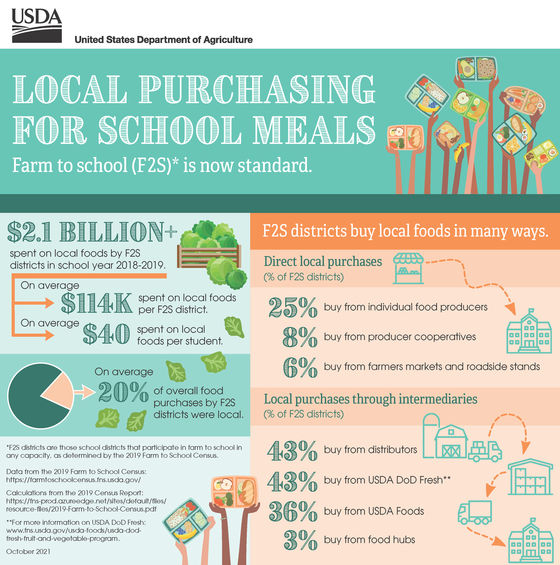 The 2019 Census also revealed that most districts are still new to farm to school; over half of F2S districts (57 percent) participated in farm to school activities for less than three years. But, they explained that, the longer they participated, the easier it was to participate.
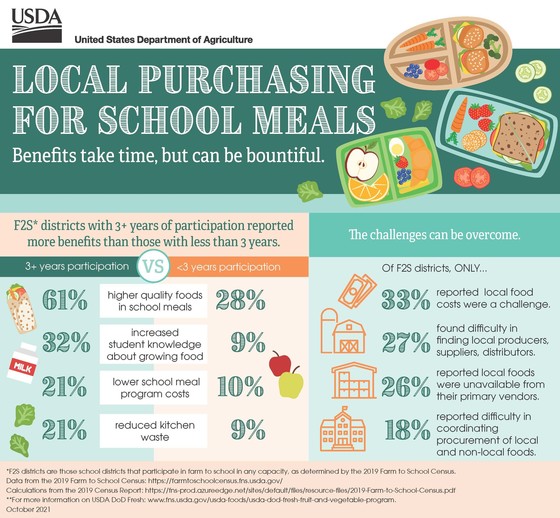
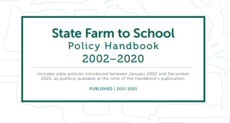
With funding from USDA’s National Agricultural Library, the National Farm to School Network and the Center for Agriculture and Food Systems at Vermont Law School published an updated State Farm to School Policy Handbook: 2002-2020. The Handbook summarizes and analyzes all 546 farm to school bills and resolutions introduced between 2002 and 2020 from the 50 states, the District of Columbia, and U.S. territories. It enables readers to search bills by both jurisdiction and topic, and includes analysis of state policy trends, case studies, advocacy resources and more.
In addition to highlighting policies that support the three core elements of farm to school and early care and education (ECE) – local procurement, school gardens, and food and agriculture education – this edition of the Handbook also spotlights policy opportunities for supporting universal school meals, supporting BIPOC producers, and those that supported farm to school responses to COVID-19.
|
USDA’s Food and Nutrition Service (FNS) is seeking feedback from a broad range of stakeholders about how the Buy American provision and guidance are currently implemented, changes FNS should make to current regulations, and how FNS can better support schools and school food authorities as they strive to purchase domestic foods and food products. The feedback FNS receives will help to inform future rulemaking and guidance on Buy American requirements in the school meals programs.
Each month, we’re highlighting the work of Farmers Market and Local Food Promotion grant recipients. This month we’re sharing stories from two AMS grant recipients that supported farm to school efforts.
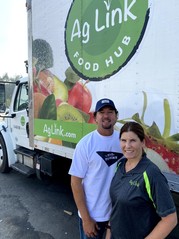
Ag Link
Ag Link, based in California, created a trusted online platform connecting farmers and school food service professionals. A Local Food Promotion Program (LFPP) grant enabled Ag Link to expand the management and staffing necessary to provide local food to schools and collaborate with regional organizations. Project funds were used to improve and expand sales to schools through networking and educating school food service buyers about locally grown products and improving distribution and logistics. During the grant project:
- Farm to school sales increased by $1,844,155, or 32% over the two years before the grant project.
- Ten new school districts started using Ag Link, reaching an additional 350,000 students.
|
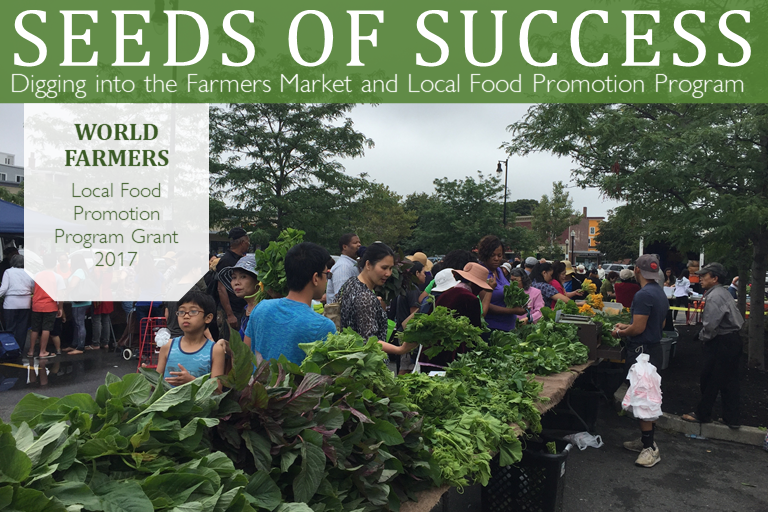 World Farmers
World Farmers Inc. is a non-profit organization based in Lancaster, Massachusetts that supports refugee and immigrant farmers. A Local Food Promotion Program (LFPP) grant supported the organization in aggregating sales of locally grown produce to mobile markets, schools, businesses, restaurants, and ethnic supermarkets, along with branding and promotions for new ethnic crops being introduced into the markets. Even during a pandemic, World Farmers continued to build relationships with schools and business opportunities with local non-profits to serve as CSA pick-up locations. Over the course of the project, 250 immigrant and refugee farmers improved their business promotion and online advertising campaigns.
|